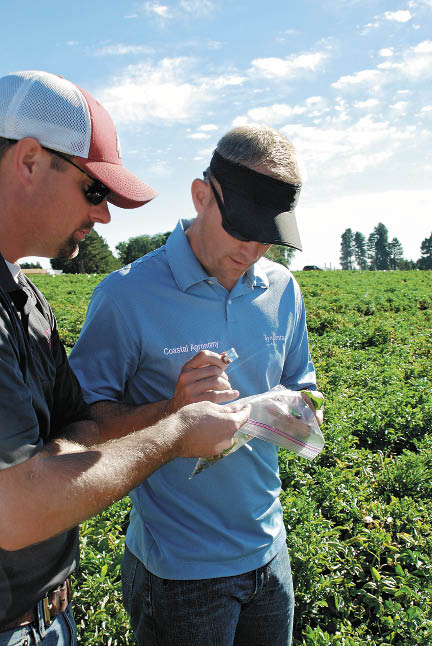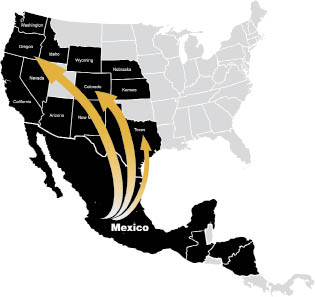 Few snacks can match the flavorful crunch of the potato chip-and few people can resist eating more than one. By some estimates, Americans consume over 4.3 billion pounds of potato chips each year. A majority comes from potatoes grown in the U.S., where soils and climate provide a solid foundation for growth-and where diseases, both old and new, provide ongoing challenges to crop yield and quality.
Few snacks can match the flavorful crunch of the potato chip-and few people can resist eating more than one. By some estimates, Americans consume over 4.3 billion pounds of potato chips each year. A majority comes from potatoes grown in the U.S., where soils and climate provide a solid foundation for growth-and where diseases, both old and new, provide ongoing challenges to crop yield and quality.
The most recent disease to hit the country's potato acreage threatens to wield a direct blow to the thriving processed potato market at large. Named after the thin striping it causes, zebra chip, once confined to Texas and other Southwestern potato-growing regions, is steadily spreading northward. The discovery of potato psyllids in southern Idaho carrying the bacterium that causes zebra chip-Candidatus Liberibacter solanacearum-in 2011 and again in 2012, confirms the disease has now reached North America's largest potato production area.
Problematic Pathogen
"There are a lot of unknowns with this disease," says Chris Clemens, Ph.D., agronomy service representative for Syngenta in Washington state. "But one thing is clear: We are dealing with something that has the potential to devastate the potato industry in the Pacific Northwest, and we don't want it to spread."
Although there is no threat to human health, the dark marks zebra chip leaves behind on tubers renders the crop unmarketable. It causes other problems as well: Infested plants produce fewer tubers, and the tubers that are produced tend to sprout prematurely in storage. Yield losses also can occur-up to 87.2 percent in a 2010 trial by Joseph Munyaneza, Ph.D., an entomologist with the USDA at the Agricultural Research Service in Wapato, Wash.
"At this time, no field west of the Mississippi River is safe from the possibility of a zebra chip outbreak," says Munyaneza, who is credited with first linking psyllids to zebra chip almost five years ago. "None of the plant growth stages are immune to zebra chip; and so far, no research has uncovered a variety that is not susceptible to the disease."
The Bacterium and the Vector
Through the collaborative efforts of the USDA, land grant universities and agribusiness partners, including Syngenta, the industry is learning more about the bacterium that causes zebra chip and the vector that spreads it.
The strain of Liberibacter that causes zebra chip is closely related to the bacterium that causes citrus greening, a disease that threatens the citrus industry on several continents, notes Munyaneza. He and other scientists know little about C. Liberibacter solanacearum, in part because culturing the bacterium in the laboratory is challenging.
"It's difficult to come out with antibiotics or bactericides if we can't get a pure culture of the bacterium," he says.
Fortunately, researchers know more about the insect vector that carries the disease. Like Potato Leaf Roll and other viruses, the bacterium that causes zebra chip is spread by insects traveling from field to field, injecting plants with the pathogen as they feed. In the case of zebra chip, it's the tiny potato psyllid that transmits the disease. A single "hot" or disease-carrying psyllid can infect a potato plant in as little as six hours of its feeding time, says Munyaneza. A group of 20 potato psyllids feeding on a potato plant can transmit zebra chip in just one hour.
Insect Control Strategy
With no bactericides or resistant potato varieties currently available to combat zebra chip, psyllid control is the only way to reduce the risk of an outbreak, says Kiran Shetty, Ph.D., potato crop specialist at Syngenta. He along with other Syngenta researchers are working with universities and the USDA to evaluate products that best address insect feeding and prevent bacteria transmission.
 "You have to target the right insect stage, because an insecticide that controls adults may not be as effective on nymphs or eggs," Shetty says.
"You have to target the right insect stage, because an insecticide that controls adults may not be as effective on nymphs or eggs," Shetty says.
The Texas potato industry offers some clues. As an assistant professor at Texas AgriLife Research in Weslaco, Don Henne, Ph.D., lives and works in an area that has been a zebra chip hotspot for over a decade. He points out that pyrethroid, carbamate and organophosphate insecticides have little to no efficacy on potato psyllid and can flare psyllid populations by eliminating beneficial insects that prey on them. The most effective insecticides are those that can actually reach the sucking insects, which hide under the host plant's foliage and are often sheltered from spray droplets.
"Unless you have a systemic or trans-laminar product, or some sort of spreader, these psyllids are difficult to control," Henne notes.
The key is having a good mix of control options and deploying them properly, says Shetty.
"Neonicitinoids like thiamethoxam, the active ingredient in Cruiser and Platinum insecticides, have been very successful as seed treatment and in-furrow applications respectively, in the Pacific Northwest over the last eight or nine years," he says, "and they have good efficacy on potato psyllids at planting, but they are only part of the solution."
Later in the season, proper scouting programs and rapid identification of the bacteria will give growers the opportunity to spray with appropriate foliar insecticides, he adds.
A variety of insecticides are effective against psyllids and fit well in overall control strategies, Shetty points out. CruiserMaxx potato insecticide/fungicide seed treatment gives good, early season protection. Fulfill insecticide, which causes insects to stop feeding shortly after ingestion, controls nymphs and minimizes the prolonged feeding that allows insects to inject the bacteria into infested plants. Agri-Mek SC insecticide/miticide provides quick knockdown of adult psyllids.
"Syngenta is here to partner with the grower to find sustainable ways to manage zebra chip," says Shetty. "We can dig deep into our toolbox to control potato psyllids, extending beyond insecticides to include better scouting tactics, better crop health management and eventually the development of new potato varieties with resistance to the disease itself. We are proud to be part of this broad-scale effort and stand ready with our products, our service and our knowledge to help growers protect their crops and their bottom lines."